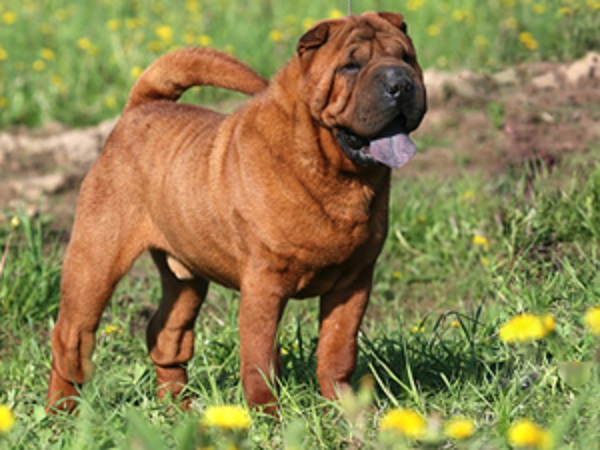
Shar-Pei

Navigate through the tabs
Navigate through the tabs below to view the breed's info of your interest.
The breed's info is divided in four sections; namely:
the breed's history ,
the breed's main stats ,
the dog's potential health issues
and finally, how the breed scored in 26 different categories.
All the above information should give you a respectively good overview for the dog of your interest.
Dog Breed's Main Info
The Breed's History:
The Shar Pei breed comes from the Guangdong province of China. The original Shar-Pei from China looked very different from the breed now popular in the West. People in southern China, Hong Kong, and Macau differentiate the Western type and the original type by calling them respectively "meat-mouth" and "bone-mouth" Shar-Pei.
The ancestry of the Shar-Pei is uncertain. It may be a descendant of the Chow Chow; however, the only clear link between these is the blue-black tongue. However, pictures on pottery suggest the breed was present even in the Han Dynasty (206 BC).
A statue on display at the Boston Museum of Fine Arts dating from the second century A.D. depicts a dog that strongly resembles a modern Shar Pei.
For many years, the Shar-Pei was kept as a general-purpose farm dog in the Chinese countryside, used for hunting, protecting and herding stock and guarding the home and family. During that time, the Shar-Pei was bred for intelligence, strength and scowling face.
DNA analysis conducted in the 2000s suggests that the Shar-Pei is one of a few ancient dog breeds believed to have split from common ancestors earlier than other breeds. In 2004, the foundational analysis of purebred dog genetics was published in Science. The resulting tree was profoundly asymmetrical.
After wolves, just four groups sat its base: Asia's shar-pei, along with shiba inu, akita and chow chow; central Africa's basenji; malamutes from the Arctic, along with Siberian huskies and samoyeds; and from the Middle East, Afghan hounds and salukis.
The Shar Pei's loose skin and extremely prickly coat were originally developed to help the dogs fend off wild boar, as they were used to hunt.
Later, the breed was used for dog fighting; these enhanced traits made the Shar Pei difficult for its opponent to grab and hold on to, and so that if it did manage to hold on, the Shar Pei would still have room to maneuver and bite back; when grabbed by any loose wrinkle, a Shar Pei can actually twist in their skin and face in one's direction.
In fighting, they would twist in their skin to bite the assailant back.
During the Communist Revolution, when the Shar Pei population dwindled dramatically, dogs were rescued by a Hong Kong businessman named Matgo Law, who in 1973 appealed to Americans through a dog magazine to save the breed. Around 200 Shar Peis were smuggled into America.
The current American Shar Pei population stems mainly from these original 200.
Country of Origin:
China
Breed Group:
Working
Height:
1 foot, 6 inch. to 1 foot, 8 inch. (45,72 to 50,8 cm)
Weight:
40 to 55 pounds (18,14 to 24,95 Kg)
Life Span:
8 to 12 years
Potential Health Issues:
Shar-Pei Fever,
Hip Dysplasia,
Cancer,
Elbow Dysplasia,
Demodectic Mange,
Hypothyroidism,
Seborrhea,
Pyoderma,
Patellar Luxation,
Gastric Torsion,
Glaucoma,
Entropion,
Osteochondrosis Dissecans (OCD),
Cutaneous Mucinosis
Adaptability
Apartment Living:
First Time Owners:
Sensitivity:
Being Alone:
Cold Weather:
Hot Weather:
Friendliness
Affection With Family:
With Kids:
With Dogs:
With Strangers:
Health and Grooming
Shedding:
Drooling:
Easy To Groom:
Overall Health:
Weight Gain Potential:
Size:
Training
Easiness:
Intelligence:
Mouthiness:
Prey Drive:
Barking or Howling:
Wanderlust:
Need For Exercise
Energy Level:
Intensity:
Exercise Needs:
Playfulness:
Our Mobile Application
Check out Our Mobile Application "Dog Breeds Central"
